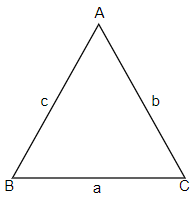Question
Question: If in a triangle ABC, \(a\cos A=b\cos B\), then the triangle is A. Isosceles triangle B. Right-a...
If in a triangle ABC, acosA=bcosB, then the triangle is
A. Isosceles triangle
B. Right-angled triangle
C. Isosceles or right-angled triangle
D. Right-angled isosceles
Solution
Hint: In order to solve this question, we should know the concept of sine law of triangle, which states that for triangle ABC, having angles as A< B and C and sides opposite to these angles as a, b, and c respectively, we can say asinA=bsinB=csinC=K. We can find the answer to this question by using this concept.
Complete step-by-step answer:
In this question, we have been asked to find the type of triangle which satisfies acosA=bcosB. To solve this question, we should know about the concept of sine law of a triangle ABC, having angles as A, B and C and sides opposite to these angles as a, b and c respectively, we can say, asinA=bsinB=csinC=K.

So, we can write the equality asinA=bsinB=csinC=K as,
asinA=K and bsinB=K
And we can further write it as,
a=KsinA and b=KsinB
Now, we will put the values of A and B in the given equality, that is, acosA=bcosB. So, we get,
KsinAcosA=KsinBcosB
Now, we know that the common term on both sides of the equation can be cancelled out. So, we get,
sinAcosA=sinBcosB
Now, we know that any number or fraction can be multiplied to both sides of the equality. So, on multiplying both sides of the equality by 2, we get,
2sinAcosA=2sinBcosB
Now, we know that 2sinθcosθ can be expressed as sin2θ. So, we can say for θ=A,2sinAcosA=sin2A and for θ=B,2sinBcosB=sin2B. Therefore, we get the above equality as,
sin2A=sin2B⇒sin2A−sin2B=0
Now, we know that sinx−siny=2cos(2x+y)sin(2x−y). So, for x = 2A and y = 2B, we get, 2x−y=22A−2B=A−B and 2x+y=22A+2B=A+B. Therefore, we get the equality as,
2cos(A+B)sin(A−B)=0
Now, we know that for the above equality to satisfy either cos(A+B)=0 or sin(A−B)=0. We know that cosθ=0 for θ=90∘ and sinθ=0 for θ=0∘. So, we can write,
cos(A+B)=cos90∘ or sin(A−B)=sin0∘
And it can be expressed further as,
A+B=90∘ or A−B=0∘
⇒A+B=90∘ or A=B
Now, we know that for a right-angled triangle, the sum of 2 angles = third angle = 90∘. So, we can say A+B=90∘ is a condition for a right-angled triangle, right angled at C.
We also know that if 2 angles of a triangle are equal, then the pair of sides opposite to these angles will also be equal, that means if A = B, then a = b. Therefore, triangle ABC is an isosceles triangle.
Hence, from both the above conclusions, we can say that triangle ABC is either a right-angled triangle or an isosceles triangle. Therefore, option C is the correct answer.
Note: While solving this question, the possible mistakes we can make is while choosing the correct option. We might choose option D, which is a single case of both the possible type of triangles. Also, we need to remember that 2sinθcosθ=sin2θ and sinx−siny=2cos(2x+y)sin(2x−y).
